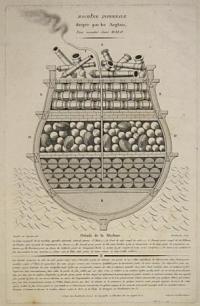Results 1-1 of 1
<<< Previous 1 Next >>>

Machine Infernale dirigee par les Anglais, Pour incendier Saint Malo. ['Details de la Machine' key lettering below image, brief history of use of incendary ships by the English below that.]
Beauble nee Gipoulou, del. Beauble fils. Sculp.
A Paris chez Beauble fils, Graveur de Geographie et d'Ecriture, Rue des Anglais, N.8. [n.d., c.1805.] Depose a la Bibliotheque.
Engraved plan in the form of a cross-section of a ship's hull, 308 x 199mm. Some creasing and soiling to margins.
A French explanation of the English innovation of cramming unmanned merchant ships with incendiaries, used to destroy harbour defences. Admiral John Benbow arrived off St. Malo, a walled port city in Brittany, in the middle of November 1693 and immediately started firing mortars over the wall in to the town and among the sheltering French ships. This continued for three days and on the fourth night he prepared to send in the first Infernal ever used by the Royal Navy. Benbow intended to manoeuvre the barque under the town's sea wall but it struck a rock and the engineers were forced to light the fuses and row for their lives. The vessel burned for some time but eventually blew up. The force of the explosion rocked the town like an earthquake. It blew the roofs off three hundred houses and broke all the glass and earthenware for miles around. The capstan, which weighed two hundred pounds, flew in to the air and, when it landed, completely levelled a house. Large parts of the sea wall collapsed. If Benbow had had a force of Marines he would undoubtedly have been able to take the town. He was given the task of repeating his success at Dunkirk but the Infernal proved less effective and the Admiralty dropped their use.
[Ref: 7707] £230.00
(£276.00 incl.VAT)
<<< Previous 1 Next >>>
